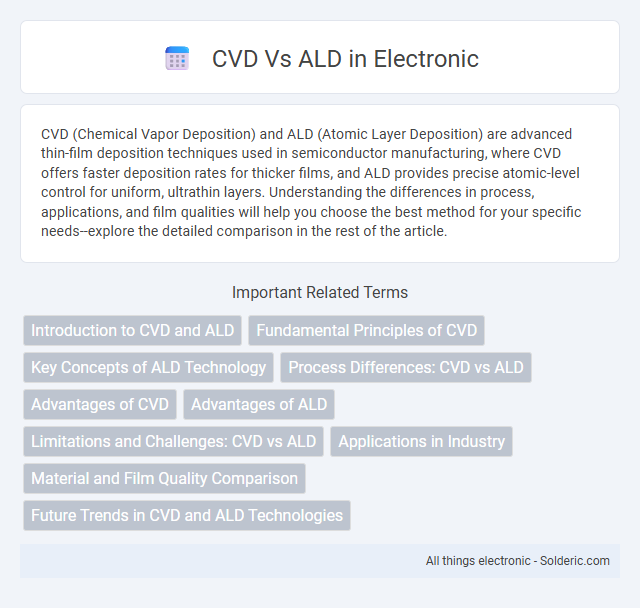CVD (Chemical Vapor Deposition) and ALD (Atomic Layer Deposition) are advanced thin-film deposition techniques used in semiconductor manufacturing, where CVD offers faster deposition rates for thicker films, and ALD provides precise atomic-level control for uniform, ultrathin layers. Understanding the differences in process, applications, and film qualities will help you choose the best method for your specific needs--explore the detailed comparison in the rest of the article.
Comparison Table
| Aspect | CVD (Chemical Vapor Deposition) | ALD (Atomic Layer Deposition) |
|---|---|---|
| Definition | Chemical process depositing thin films from vapor-phase precursors | Layer-by-layer deposition using self-limiting surface reactions |
| Film Thickness Control | Less precise; thickness controlled by reaction time and conditions | Atomic-scale precision; thickness controlled by number of cycles |
| Uniformity | Moderate uniformity, affected by reactor design | Excellent conformality and uniformity over complex surfaces |
| Deposition Rate | Generally faster deposition rates | Slower deposition due to sequential reactions |
| Applications | Semiconductors, coating, solar cells, hard films | High-k dielectrics, gate oxides, thin barriers, nanolaminates |
| Temperature Range | Typically higher temperatures (300-1000degC) | Lower temperatures (100-300degC), suitable for sensitive substrates |
| Film Quality | Good density but potential for impurities | High purity, dense films with minimal defects |
Introduction to CVD and ALD
Chemical Vapor Deposition (CVD) and Atomic Layer Deposition (ALD) are advanced thin-film fabrication techniques used in semiconductor manufacturing and nanotechnology. CVD involves the chemical reaction of gaseous precursors on a substrate to form a solid material layer, offering high deposition rates and conformality on complex surfaces. ALD is a subcategory of CVD characterized by sequential, self-limiting surface reactions that enable precise control of film thickness and composition at the atomic scale.
Fundamental Principles of CVD
Chemical Vapor Deposition (CVD) operates on the principle of chemical reactions between gaseous precursors and a substrate surface, resulting in the deposition of a solid material in thin-film form. This process relies on controlling temperature, pressure, and gas flow to achieve uniform, high-purity coatings essential in semiconductor manufacturing, solar cells, and protective coatings. Unlike Atomic Layer Deposition (ALD), which uses self-limiting reactions for monolayer precision, CVD offers faster deposition rates suitable for thicker films with excellent conformality and material versatility.
Key Concepts of ALD Technology
Atomic layer deposition (ALD) technology relies on sequential, self-limiting surface reactions to deposit thin films with atomic-scale precision, enabling uniform coating on complex 3D structures. Unlike chemical vapor deposition (CVD), which uses continuous gas flow and can result in less controlled film thickness, ALD achieves conformal layers through its cyclic exposure process. This precise control over film thickness and composition makes ALD ideal for applications in semiconductor fabrication, nanotechnology, and advanced material engineering.
Process Differences: CVD vs ALD
Chemical Vapor Deposition (CVD) involves continuous gas-phase reactions where precursor molecules decompose or react on a heated substrate surface, leading to film growth through simultaneous adsorption, reaction, and desorption steps. Atomic Layer Deposition (ALD) relies on sequential, self-limiting surface reactions where precursor gases are pulsed alternately, allowing precise monolayer deposition with excellent thickness control and conformality over complex surfaces. CVD typically enables higher deposition rates but offers less control over film uniformity and thickness compared to the atomic-scale precision and uniformity characteristic of ALD processes.
Advantages of CVD
Chemical vapor deposition (CVD) offers superior film uniformity and conformality compared to atomic layer deposition (ALD), making it ideal for coating complex 3D structures. CVD processes typically deliver higher deposition rates and better throughput, enhancing manufacturing efficiency for large-scale applications. Your choice of CVD ensures robust, high-quality thin films with scalable production advantages.
Advantages of ALD
Atomic Layer Deposition (ALD) offers superior thickness control at the atomic scale compared to Chemical Vapor Deposition (CVD), enabling precise film uniformity and conformality on complex 3D structures. ALD operates at lower temperatures, making it ideal for temperature-sensitive substrates and semiconductor devices. Its self-limiting surface reactions prevent over-deposition, resulting in highly reproducible thin films with excellent step coverage and minimal defects.
Limitations and Challenges: CVD vs ALD
Chemical Vapor Deposition (CVD) faces challenges like non-uniform film thickness, higher processing temperatures, and less precise thickness control, limiting its use in nanoscale applications. Atomic Layer Deposition (ALD) offers superior conformality and atomic-level thickness control but suffers from slower deposition rates and higher equipment costs. Both methods require careful optimization for material compatibility and scaling up from laboratory to industrial production.
Applications in Industry
Chemical Vapor Deposition (CVD) and Atomic Layer Deposition (ALD) are pivotal in semiconductor manufacturing, with CVD widely used for producing high-quality films like silicon dioxide and nitrides, essential for microelectronic devices. ALD offers unparalleled precision in thin film thickness control, ideal for complex nanostructures in advanced electronics and memory devices. Your choice between CVD and ALD hinges on the required film conformity, thickness accuracy, and specific industrial applications such as photovoltaics, catalysis, or protective coatings.
Material and Film Quality Comparison
CVD (Chemical Vapor Deposition) typically produces high-purity, conformal films with excellent step coverage and uniformity, ideal for complex 3D structures. ALD (Atomic Layer Deposition) offers superior thickness control at the atomic scale, resulting in ultra-thin, pinhole-free films with exceptional uniformity and excellent conformality on high-aspect-ratio features. Both methods yield high-quality materials, but ALD excels in precise thickness modulation and film uniformity, while CVD is preferred for faster deposition rates and thicker films.
Future Trends in CVD and ALD Technologies
Future trends in Chemical Vapor Deposition (CVD) and Atomic Layer Deposition (ALD) technologies emphasize enhanced precision for nanoscale fabrication and increased material diversity, including complex oxides and 2D materials. Innovations in plasma-enhanced methods and low-temperature processes aim to improve film conformity and reduce substrate damage, critical for advanced semiconductor and flexible electronics manufacturing. Your choice between CVD and ALD will increasingly depend on specific application demands for uniformity, thickness control, and integration with emerging device architectures.
CVD vs ALD Infographic

 solderic.com
solderic.com